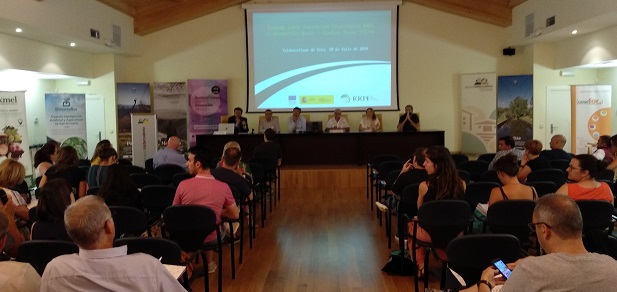
22 de July de 2019
July 22, 2019. People involved in technological innovation in rural areas gathered in Valdeavellano de Tera (Soria) to present and learn about projects carried out by Operational Groups and how their implementation impacts the development of rural areas and improves the quality of life of the people who live there.
The National Rural Network of the Ministry of Agriculture, Fisheries and Food organized this event, with the collaboration of El Hueco , the Valdeavellano de Tera Town Council , and Sonorama Ribera . The event showcased various innovative technological projects launched thanks to European co-financing from the EAFRD ( Federal Agricultural Development Fund), through the regional Rural Development Programs (RDP) and the National Rural Development Program .
The Operational Groups are groups of stakeholders from diverse backgrounds who join together to solve problems or take advantage of opportunities related to rural areas. This joint, multisectoral approach was exemplified during the event through the presentation of nine projects that contribute to promoting the agri-food and forestry sectors.
For example, the improvement of forest management and related processes is the area of development of the groups Forest Lida Rioja and Monte Digital , which use ground-based and aerial LiDAR sensors to obtain data for making informed decisions; or the SAXMEL Group, which develops a local support system for forest management. Chainwood uses blockchain technology and the Internet of Things to optimize wood supply chain processes, offering guarantees at every stage.
The development of the first mechanical grading system for Scots pine and the production of highly durable heat-treated sawn timber are two of the main areas of activity of the Binomio Madera y Agricultura Group, seeking to improve the wood processing process.
How to use natural resources is also an area of innovation supported by the RDPs; monitoring humidity through the use of sensors allows for efficient use of irrigation water, as explained by the Bihortalflor , InnoBobal , and EcoInv groups, while safeguarding the specific characteristics of each.
The improvement in the energy efficiency of poultry farm facilities has also been presented by the Gestión 4.0 Group, in poultry farms that implement a smart climate control system to achieve this goal, while also improving animal welfare. The COOVA Group is also advancing in the modernization of livestock farms, in this case thanks to the use of electronic ear tags on sheep, guaranteeing traceability from the point of production to distribution and sale. For its part, IXORIGUE uses technological tools such as Big Data, the Internet of Things, and drones , among others, to achieve livestock traceability through electronic collars .
Beekeeping also had a place at the event with the supra-regional Operational Group Innomiel 's ultimate goal is to increase farm competitiveness and efficiency through remote monitoring of hives and apiaries . It is also promoting the development of a mobile app that will allow users to monitor their farms and, therefore, make more precise management decisions.
The conference demonstrated how innovation and the application of technology in the agri-food and forestry sectors contribute to improved decision-making in management, resulting in a more competitive sector with a lower environmental impact. Innovation is currently a cross-cutting priority in rural development policy (2014-2020), and the Operational Groups are a key tool in developing the European Innovation Partnership for Productive and Sustainable Agriculture (EIP-agri). Looking ahead, innovation will continue to be a strategic component of the new post-2020 CAP , which will be reflected as a cross-cutting objective, along with digitalization.
The National Rural Network , which acts as a driving force for innovation by promoting the creation of Operational Groups and the development of innovative projects, as well as disseminating their results, organized this fruitful meeting where participants and attendees were able to debate, reflect, resolve doubts, and find solutions regarding technological innovation.











